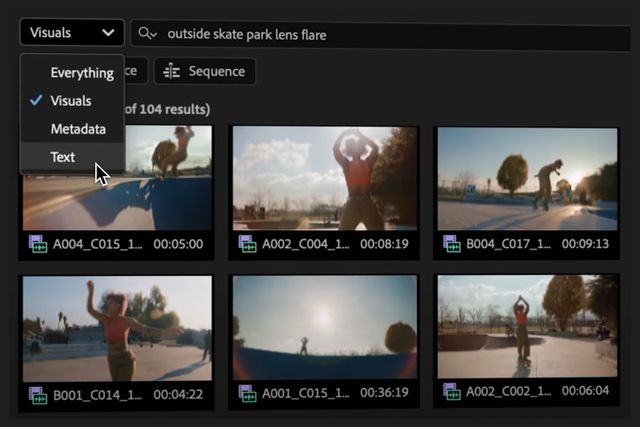FilesAdobe Premiere Pro, a cornerstone in video editing software, has introduced a groundbreaking feature designed to transform the way you interact with your video projects. By integrating advanced AI-driven technology, Adobe now allows users to find video clips by simply describing them. This feature promises to save countless hours in the editing process, making it a game-changer for professionals and enthusiasts alike.

For years, video editors have faced the arduous task of manually sorting through vast libraries of footage to find specific clips. This new tool eliminates much of that drudgery by employing Adobe’s proprietary AI system, Sensei. The system can analyze the visual and contextual elements of your media library and identify clips based on your descriptive input. For example, typing “a sunset over a mountain range” will instantly narrow down your options to footage matching that description.
This advancement is part of Adobe’s broader commitment to incorporating artificial intelligence into its Creative Cloud suite. AI has long been a buzzword in technology, but Adobe’s implementation of it in Premiere Pro sets a practical precedent for how this technology can directly enhance productivity. By bridging the gap between human intent and machine learning, Adobe has introduced a feature that feels intuitive and almost indispensable from the first use.
The innovation is particularly valuable for editors working on large-scale projects. Whether you’re a filmmaker piecing together a feature-length movie or a content creator producing regular uploads for social media platforms, managing footage can be a logistical nightmare. Even with meticulous labeling and categorization, finding the right clip often requires manually skimming through hours of footage. Adobe’s description-based search eliminates the need for exhaustive labeling, letting the software handle the heavy lifting.
For professionals in the news or documentary industry, where timeliness is critical, this feature can significantly reduce turnaround times. By enabling a more fluid and efficient workflow, it allows editors to focus on storytelling rather than logistical challenges. This efficiency is not limited to large-scale productions. Hobbyists and amateur editors, who might lack the resources to organize extensive footage libraries, also stand to benefit.
Adobe’s new tool is not only efficient but also remarkably accessible. It integrates seamlessly into the existing Premiere Pro interface, requiring no additional installations or steep learning curves. When you access your project, you can now enter descriptive phrases directly into the search bar to retrieve relevant clips. The system supports a wide range of descriptors, from basic actions and objects to more nuanced details like lighting, color schemes, or camera angles.
Here’s where this feature becomes particularly powerful: it doesn’t merely rely on metadata or pre-existing tags. Instead, it uses machine learning to analyze each frame of your footage, understanding context and visual cues. This level of sophistication means that even poorly labeled or unlabeled clips can be easily found. For instance, if you’re working with a file labeled “DCIM_0150.mov” but need footage of a city street at night, a simple description like “nighttime city street” will pull up the appropriate content without requiring you to remember file names.
To better understand the impact of this feature, consider the typical workflow for a professional editor before and after this tool’s introduction.
| Workflow Stage | Traditional Method | With Adobe’s Descriptive Search Tool |
|---|---|---|
| Footage Import | Manual sorting and labeling | Automated AI analysis and categorization |
| Clip Search | Skimming through hours of video | Instant results based on descriptions |
| Timeline Assembly | Relies on memory and detailed tags | Relies on AI for precise retrieval |
The table underscores how this tool fundamentally shifts the editing process. Time saved in the initial stages translates into more room for creativity and fine-tuning later on.
Adobe has also emphasized that this feature is designed to evolve. As you use it, the system learns from your preferences and input, becoming more accurate over time. This adaptive quality ensures that the tool remains relevant, even as your editing needs change. Additionally, Adobe is committed to refining the AI model through regular updates, incorporating feedback from its vast user base.
While this feature is undeniably groundbreaking, it’s worth addressing some potential limitations. The accuracy of search results may depend on the quality and clarity of your footage. Clips with ambiguous or low-contrast visuals could present challenges for the AI. However, Adobe has anticipated such issues by offering tools to refine and customize your searches. By combining descriptive phrases with filters like time range or project metadata, you can further narrow down your results.
The rollout of this feature reflects Adobe’s ability to anticipate and respond to user needs. As the video production industry continues to grow, the demand for more efficient workflows has never been higher. Adobe has positioned itself at the forefront of this trend, offering tools that not only streamline the editing process but also enhance creative possibilities.
For you, as an editor, this feature could fundamentally change the way you approach your projects. By removing one of the most time-consuming aspects of video editing, Adobe allows you to focus on what truly matters: crafting compelling stories. Whether you’re editing a corporate video, a personal vlog, or an independent film, this tool ensures that your creative vision is not hindered by logistical bottlenecks.
In conclusion, Adobe Premiere Pro’s ability to find video clips based on descriptions represents a significant leap forward for the industry. It’s a testament to the potential of artificial intelligence when applied thoughtfully and effectively. By making your workflow faster and more intuitive, Adobe has created a tool that is likely to become an essential part of your editing toolkit. This is not just an incremental update but a transformative feature that sets a new standard for what video editing software can achieve. With this innovation, you are empowered to create without constraints, knowing that the tedious aspects of your work are being handled with precision and efficiency.










Add Comment